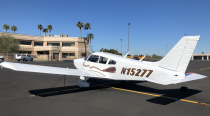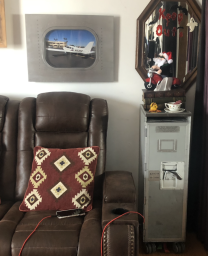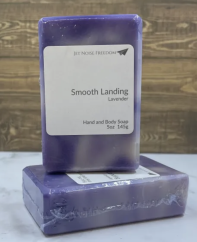
Buy & Sell Aircraft
Adobe Acrobat document [3.5 MB]
Flying Magazine articles dealing with aircraft ownership:
How to Save Big on a Used Airplane
Aircraft Purchasing
Starts out with finding the aircraft that's best for you - deciding what to buy - often hard to differentiate between what you want and what you need - look to mission, as in what you will need 80-85% of the time - consider:
* where you will fly
* how often you will fly
* will you carry passengers
* VFR or IFR
* cost to fly and maintain
* aircraft range
- the purchase process
* inspections
*paperwork
* title services
- insurance
- finalizing the deal
Sharing the cost -
* co-ownership
* flying clubs (more than cost savings, encouragement and information, family activities, AOPA flying club resources)
Where to look -
* Airport Bulletin Boards
* Popular Websites
* Type Club websites (classifieds)
RED FLAGS to beware of
* aircraft that do not meet your defined mission
* logbooks and ownership records that do not agree
* unmanaged corrosion
* aircraft beyond your financial or piloting means
Vref (aircraft value reference)
* for piston equipment
* sales/use tax info
* comprehensive information on most aircraft
* each aircraft is different
* view online or call AOPA - 800-USA-AOPA - 800-872-2672
Financing -
* interest rate depends on amount of loan and type of aircraft
* larger loans get lower rates
* AOPA Aviation Finance - monthly payment calculator - 15-20 year amortization rate - 15% down - 4.75% rate over $100K
6.5% rate under $100K
(roughly equates to $250 a month)
* continuing ownership costs - aircraft operating costs calculator
1. monthly loan payment
2. Maintenance (contact local mechanic) - guide to aircraft inspections
3. Hangar
4. Inspections
5. Fuel/hour
6. Oil change (50-hour interval)
7. additional oil
8. overhaul reserve
9. Maintenance reserves
10. Annual inspection
11. Insurance
12. Database updates
13. Tie-down rental
(Note: ask to see seller's last 2 years for annual inspections breakdowns)
Pre-purchase inspection typically lasts 3-4 hours at $100 an hour
ADS-B units - $2,000 - $5,000 plus installation at 10-15 hours for $100 an hour
Before you buy -
* talk with experienced owners
* have a mechanic do a pre-purchase inspection and flight
* ideally, the mechanic should have experience with that type of aircraft
* thorough logbook review
* preapproval if you are financing (so you can walk into deal already armed with financial backing of a lender - loans could take 4-6 weeks - specific to make and model - usually good for 60 days)
Pre-purchase inspection -
* not necessarily an annual - can vary widely in scope and cost - make it clear what you want done
* review of logbooks and other records including - FAA Form 337 - AD list
* written report of aircraft and logbook review
* decide how to handle discoveries
* schedule a final inspection prior to delivery
Getting an appraisal
- necessary part of aircraft acquisition process
- there are three types of appraisal
1. Pricing guide appraisal
least expensive
least comprehensive
Vref or Aircraft Bluebook
good for 90% of aircraft transactions
analysis is only as accurate as the information put into it (so it's subject to biases from lender perspective, seller perspective and buyer perspective)
not part of this appraisal are the nuanced differences between actual market values based on current demand versus costs for things such as STC modifications, avionics and engine monitoring upgrades, and interpretation of paint and interior quality
2. Desktop appraisal
done by a certified appraiser
they may start with the pricing digests but then expand their analysis to include market data
they look at comparable sales, type-specific trends, average "days on market" for similar aircraft
more sophisticated, more powerful aircraft garner additional appraisal criteria
typically costs $500-$600
3. Physical appraisal
most extensive, most hands-on, most precise way to appraise an aircraft
most expensive - about $2,000-$4,000
similar to a pre-buy inspection
combines all aspects of desktop and pricing guide appraisals with an actual on-site inspection of the aircraft
ideal for unique, "orphan" or highly modified aircraft
bulletproof assessment of an aircraft's true value
Legal issues -
* get your agreement in writing before pre-purchase inspection (sale of goods $5000 or more)
* use an aviation attorney in state of delivery/aircraft will reside
* AOPA PPS legal services plan includes a 1-hour consultation, which can be used for your purchase agreement - $49/year (PPS plus includes 2 hours for $99)
* include in the sales contract:
1. Identification of parties
2. Aircraft description
3. Price
4. Deposits (refundable or not)
5. Closing (use title and escrow services - have parties split cost
6. Contingencies
7. Delivery of aircraft
8. Transfer of title/risk of loss
9. Taxes
10. Title warranties
11. Pre-Purchase Inspection
12. Aircraft condition (as is - with all faults)
13. Agreement modifications
14. Dispute resolution and governing law
Pitfalls to avoid -
* names must exactly agree on bill of sale and registration
* Aircraft registration - Form 8050-1 - must be original - no copies
* PO Box must include a physical location
* possible title liens
* risk of fraud without escrow service
Aircraft Title and Escrow Services - Aero Space Reports
* title search package includes title search - complete aircraft records - accident/incident history
* $95/AOPA members - 2-day turn-around
* title clearing, if necessary
* title insurance
* closing - escrow instructions - document filings
* aircraft title and escrow services
Insurance
* limits of liability and hull
liability: highest you can reasonably afford
hull: replacement value of aircraft
* named and approved pilots (unless open pilot clause)
* be aware of terms particular to your operation (e.g. business and pleasure, industrial aid, etc.)
* know sublimits or per passenger or smooth
* for over 20 years have insured more GA aircraft - including light sport, turbine, and experimental planes - than anyone else in the world
* have access to all major carriers with "A" ratings and will provide you with coverage options to fit your needs
Bill of Sale
complete blue areas
seller must sign in ink
FAA does not care about amount
Sales and Use Tax
* laws vary by state - aircraft is taxed in the state where it is based - take delivery - NOT PURCHASED - look for flyaway exemption 10-15 days)
* personal property tax in some states - can vary by county and city as well
* State use tax could be as high as 8-9%
Note: states regularly check FAA registry and FBO-based aircraft list
Arizona DOT - aircraft services
Federal Income Tax
* business use - profit motive - ordinary, necessary, and reasonable - actual deductions are for % of hours that are business
Final Inspection
* visually inspect the aircraft before signing
* no damage since the pre-purchase inspection
* all contract conditions fulfilled
* transfer necessary documents
FAA paperwork to send - aircraft certification
* 8050-1 - Registration application - takes 3-6 weeks - temporary registration good for 90 days
* 8050-2 - Bill of Sale
* 8050 -3 - Existing registration from aircraft (previous owner signs the back of the form)
* $5 recording fee - check made out to FAA
Note: airworthiness certificate stays in aircraft
For LLCs or Corps: Have statement of support of the Registration of US civil aircraft in name of LLC
However, a federal law exists to preempt these state laws and protect owners, lessors, and financers, as long as certain conditions are met. Yet owners must remain cautious, as some courts may still disagree about the law’s intent and the protection it provides.
49 U.S. Code Section 44112 Limitation of Liability states, in part, that a “lessor, owner, or secured party is liable for personal injury, death, or property loss or damage only when a civil aircraft, aircraft engine, or propeller is in the actual possession or operational control of the lessor, owner, or secured party.” Most cases about this law involve arguments about what Congress intended the law to do, inevitably turning into painstakingly detailed discussions of the legislative history of the 1948 federal law that would eventually become present-day Section 44112.
The predecessor of Section 44112 was enacted in 1948 in response to some states adopting the Uniform Aeronautics Act, which declared that the owner of every aircraft was “absolutely liable” for injuries caused by the aircraft’s flight regardless of the owner’s degree of control of the aircraft. Concerned this would stifle the aviation industry, Congress passed the 1948 statute to limit this liability. Recodifications and modifications were made in 1958 and 1994, which among other changes, added definitions for “lessor” (leasing at least 30 days), “owner,” and “secured party.”
Many state and federal courts that have considered the law ultimately concluded that it preempts conflicting state statutes and common law claims, but such cases often involve a fact-specific analysis to determine that the owner, lessor, or secured party did not have actual possession or operational control of the aircraft at the time of the accident. Although not defined by statute, “operational control” is defined by FAR 1.1 as “the exercise of authority over initiating, conducting or terminating a flight.” (See “For the Record: Who’s In Control Here?” March 2020 AOPA Pilot.)
Unfortunately, some courts have adopted nuanced interpretations of Section 44112 that limit its preemptive effect, with some notable examples leading Congress to amend the statute once more to preserve its original objective. One such case involved a prior, but substantially similar, version of the law that provided an aircraft owner or lessor was liable “for personal injury, death, or property loss or damage on land or water.”
In that 2011 case, the Florida Supreme Court limited the preemptive effect of the law depending on whether the injured party was on the ground or a passenger on the aircraft. The case involved the crash of a leased airplane that killed the pilot and the only passenger. The estate of the passenger sought to hold the aircraft’s owner liable by relying on Florida’s “dangerous instrumentality” doctrine, which imposed strict liability on the owner of a motor vehicle (including aircraft) who gave express or implied consent to the operation. The court, focusing on the “death…on land or water” language in statute at the time, concluded that Section 44112’s “limitation on liability would apply only to individuals and property that are underneath the aircraft during its flight, ascent, or descent,” and the claim against the owner was not preempted because the passenger died inside the aircraft that crashed, rather than while standing on the ground. A dissenting judge stated the interpretation “defies reality” as the passenger was in the aircraft and died when it hit the ground.
In 2018, Congress passed an FAA reauthorization that eliminated “on land or water” from Section 44112—but there remains the possibility that future courts may adopt other unexpected interpretations that may again limit the law’s preemptive effect. Such decisions would likely have significant implications relating to insurance and ownership entity choice for aircraft owners.
Aircraft owners should remember that while Section 44112 may limit liability, it probably won’t prevent a lawsuit from being filed. When an owner raises Section 44112 as a defense, it will likely result in the court closely scrutinizing the facts as to who had actual possession or operational control at the time of the accident.
For now, owners who lease their aircraft should include lease terms transferring operational control to the lessee (and make certain that lessees truly exercise operational control), ensure their insurance policy has appropriate liability coverage, and remain vigilant when negotiating indemnity clauses and insurance provisions with a prospective lessee of an aircraft.
Most litigation over aircraft purchases arises because:
1. Buyer and Seller did not come to a clear agreement on all aspects of the transaction and failed to properly document the deal, especially aircraft condition
2. Buyer failed to commission an adequate pre-purchase inspection and title search before buying the aircraft, and/or
3. transaction was not properly documented and recorded with the FAA Aircraft Registry and the new International Registry
State law largely governs the buying and selling of aircraft, with federal law only peripherally involved
Fortunately, the law of all 50 states is now virtually identical with the adoption of the Uniform Commercial Code (UCC)
Where a federal statute provides a system for recording documents of ownership and security interests in a specific class of products, federal law prevails
e.g. with aircraft under the Federal Aviation Act of 1958, as amended
Sale of an aircraft raises legal considerations not only for the buyer and seller but also for any lender who may be financing the purchase for the buyer and any person/business that may already hold a security interest in the aircraft
Buyer: state law - law of warranty covered by UCC - as to product and law of security interests as to title
Security Interest
Legal interest in an item of personal property that secures the payment of a debt - person/business may acquire a security interest in an aircraft by loaning money to the purchaser and obtaining a written security agreement signed by the purchaser, by performing work or furnishing goods/services to the aircraft (mechanics' and materialmen's liens or artisans' liens) or by providing storage for the aircraft (warehousemen's liens)
If the aircraft owner does not pay the debt when due, the holder of a security interest has the right to take possession of the aircraft (or to retain possession e.g. repair station) even without resorting to judicial process, so long as no breach of peace
Adobe Acrobat document [58.3 KB]
Perfection and Priority
Except for aircraft and engines covered by the Cape Town Treaty, filing the security agreement with the FAA Aircraft Registry perfects a non-possessory security interest in an aircraft
If a lienholder who is not in possession of the aircraft fails to record a security agreement with the FAA Aircraft Registry, a buyer who is not otherwise aware of that security interest (aka a good faith purchaser without notice) takes clear title, and the lienholder's security interest is unenforceable
In the event of several security interests in an aircraft having a total value that may exceed the value of the aircraft - if the aircraft owner is unable or unwilling to pay these debts, the question of priority among the holders of these security interests becomes important
Any unpaid lienholder may repossess the aircraft and dispose of it per the UCC - in any commercially reasonable manner, with notice of sale to the aircraft's registered owner required before the sale can take place
If proceeds of sale are greater than total of all possessory and recorded security interests, all lienholders receive entire amounts owed and surplus goes to pre-repossession aircraft owner
If proceeds of sale are less than total of all possessory and recorded security interests, order of priority set forth below applies:
- person having possession of aircraft under possessory lien for parts, labor, materials, or services has first priority - entitled to be
paid in full (possession 9/10s of law!)
- between holders of recorded security interests (filed with FAA Aircraft Registry) priority runs from date and time of filing (first in time, first in right) - first entitled to be paid in full,
then next in line etc.
Release of Liens
If for some reason an FBO, mechanic, or repair station releases an aircraft after being worked on but before the bill is paid, then it may have the aircraft owner sign a promissory note for the amount due, secured by a security agreement, giving the creditor a security interest in the aircraft - these documents should be filed with the FAA Aircraft Registry
If aircraft is released without these, lien is extinguished
If this procedure is followed, lien is preserved (at lower priority behind other previously recorded security interests)
If a lien does exist the buyer should ensure lienholders are paid out of proceeds of sale and provide buyer a lien release which can then be filed with FAA Aircraft Registry to clear that security interest off aircraft's records
Cape Town Treaty
Added additional filing requirements for security interests and leases in certain aircraft and components
Physically located in Dublin - Ireland
Operates entirely via secured transactions online - 24/7/365
Facilitates financing
Reduces financing costs for international aircraft transactions
Creates international legal process for repossession that enables a secured lender, following a default, to deregister the aircraft and obtain its export from a country that has ratified the treaty, to take possession or control of the aircraft or sell or grant a lease of the aircraft, and to collect and receive income or profits from the management or use of the aircraft
Requirements are not retroactive - apply only to transactions on or after the treaty's effective date
Interests that can be registered under the treaty:
* security agreements
* conditional sales contracts
* lessor's interest under a lease
* assignments
* bills of sale
* subordination agreements
* subrogation agreements
* amendments
* discharges (terminations and releases)
* extensions of any of the above
* prospective interests - eg transaction to accomplish any such listed interest that has not yet closed
As adopted in the United States by The Cape Town Treaty Implementation Act of 2004 - August 9, 2004 which:
- Recognizes the International Registry as an additional place for the filing of interests, including prospective interests, in certain airframes, helicopters, and aircraft engines.
- Establishes the right for owners of these aircraft to grant an Irrevocable De-Registration and Export Request Authorization (IDERA) to a secured party.
- Reduces from 750 to 550 rated take-off shaft horsepower the size threshold for aircraft engines eligible to be recorded as collateral in security instruments.
- Establishes the Civil Aviation Registry as the Authorizing Entry Point.
The effective date of these changes is March 1, 2006.
Aircraft and Aircraft Engines Eligible for International Registry Recording:
- Airframes that are type certificated to transport:
- At least eight (8) persons including crew; or
- Goods in excess of 2750 kilograms (6050 pounds)
- Helicopters that are type certificated to transport:
- At least five (5) persons including crew; or
- Goods in excess of 450 kilograms (990 pounds)
- Jet propulsion aircraft engines with at least 1750 pounds of thrust or its equivalent.
- Turbine-powered or Piston-powered aircraft engines with at least 550 rated take-off horsepower or its equivalent.
Perfection
- by filing - 2 steps
1. file with FAA Aircraft Registry
2. file with International Registry (must file with FAA first to be accepted)
Priority
Whoever files first has priority over all others
e.g. a lender that files its security agreement with the FAA but fails to also register it with the International Registry risks losing its priority to a subsequent creditor that registered its interest with the International Registry even if the subsequent creditor was aware of the prior lien
Prospective interest is effective from the date of filing assuming the transaction is later completed
Searching the International Registry
search both FAA and international registries
for International Registry - person must first obtain a priority search certificate from registry for particular aircraft or engine that is subject of inquiry
title search companies routinely perform searches of both for their clients
Warranty
Statement or representation made by seller regarding year of manufacture, make and model, equipment, condition, and title - state law under UCC governs - 2 categories:
1. Express Warranties - not required to be in writing - may be created verbally - need not be in any particular form - highly suggested that you do in fact put them in writing to avoid litigation later
UCC 2-313:
(1) Express warranties by the seller are created as follows:
- (a) Any affirmation of fact or promise made by the seller to the buyer which relates to the goods and becomes part of the basis of the bargain creates an express warranty that the goods shall conform to the affirmation or promise.
- (b) Any description of the goods which is made part of the basis of the bargain creates an express warranty that the goods shall conform to the description.
- (c) Any sample or model which is made part of the basis of the bargain creates an express warranty that the whole of the goods shall conform to the sample or model.
(2) It is not necessary to the creation of an express warranty that the seller use formal words such as "warrant" or "guarantee" or that he have a specific intention to make a warranty, but an affirmation merely of the value of the goods or a statement purporting to be merely the seller's opinion or commendation of the goods does not create a warranty.
Affirmation of fact: statement of fact or promise made as part of a bargain
Mere commercial puffery: exaggerated or extravagant statement made for the purpose of attracting buyers to a particular product/service - commonly used with advertising and promotional sales testimonials - does not create a warranty - some stuff is allowed e.g."it's a fantastic little airplane; you won't find a better one anywhere!"
2. Implied Warranties (2 kinds)
Implied warranty of merchantability
To be airworthy, an aircraft must be in its original or properly altered (in accordance with FARs) condition, as verified by the logbooks and maintenance records - the fact that the aircraft will fly is NOT proof enough!
UCC 2-314
(1) Unless excluded or modified (Section 2-316), a warranty that the goods shall be merchantable is implied in a contract for their sale if the seller is a merchant with respect to goods of that kind. Under this section the serving for value of food or drink to be consumed either on the premises or elsewhere is a sale.
(2) Goods to be merchantable must be at least such as
- (a) pass without objection in the trade under the contract description; and
- (b) in the case of fungible goods, are of fair average quality within the description; and
- (c) are fit for the ordinary purposes for which such goods are used; and
- (d) run, within the variations permitted by the agreement, of even kind, quality and quantity within each unit and among all units involved; and
- (e) are adequately contained, packaged, and labeled as the agreement may require; and
- (f) conform to the promise or affirmations of fact made on the container or label if any.
(3) Unless excluded or modified (Section 2-316) other implied warranties may arise from course of dealing or usage of trade.
Implied warranty of fitness for a particular purpose
UCC 2-315
Where the seller at the time of contracting has reason to know any particular purpose for which the goods are required and that the buyer is relying on the seller's skill or judgment to select or furnish suitable goods, there is unless excluded or modified under the next section an implied warranty that the goods shall be fit for such purpose.
Disclaimer of Warranties
UCC does permit sellers to disclaim some warranties
Written express warranties CANNOT be disclaimed
Oral express warranties and implied warranties MAY be disclaimed - must be in writing and conspicuous
Implied warranties CAN be disclaimed by use of:
- "there are no warranties which extend beyond the description of the aircraft on the face of this agreement, including, but not limited to, any implied warranty of merchantability" or
- "the aircraft is delivered and accepted as is, with all faults" or
- other language that in common understanding calls the buyer's attention to the exclusion of warranties and makes it plain that there is no implied warranty
When the buyer before purchasing the aircraft has examined it thoroughly (or had the opportunity to examine it but refused to) there is no implied warranty covering defects that such an examination ought to have revealed
Breach of warranty claims
If warranty is breached, buyer must notify seller and give him an opportunity to correct ("cure") the problem
If seller fails or refuses to fix the problem, buyer may sue for breach of warranty seeking:
- specific performance (court order for seller to correct the deficiency at its expense) or
- damages (judgment ordering seller to reimburse buyer cost of repairs) or
- rescission (judgment ordering seller to refund purchase price and take back aircraft)
How to Avoid Litigation
Contract of sale: in the interest of both buyer and seller to have a written purchase contract clearly expressing the warranties agreed to or excluded from the deal, written by a lawyer or negotiated between parties both represented by lawyers
Conditional sale contract: unique form of secured transaction typically providing that title to the aircraft does not pass to buyer until the debt is paid in full - if buyer misses a payment or is late in submitting a payment, seller still holding title can legally repossess the aircraft and buyer gets nothing back
Prepurchase Inspection
hire an aircraft mechanic to perform a prepurchase inspection - someone you know and trust or who has an excellent reputation - A&P with IA having special experience and familiarity with particular make and model - with access to ADs and SBs
nothing less than an annual inspection (C check for turbine-powered aircraft)
Title Search
Performing title searches at both the FAA Aircraft Registry and the International Registry should reveal not only who owns an aircraft but also all recorded security interests outstanding against the aircraft
AOPA Aircraft Title and Escrow Services will also perform a title search for a modest fee - typically backed up with title insurance protecting you against any error in their report
If you are borrowing to purchase the aircraft, the lender will require that you purchase a title search as a precondition of making the loan
The International Registry requires that the party performing the search first register (may take several days) and pay a fee for access
One type of security interest that a title search may not reveal is the possessory lien
Aircraft title insurance
Most appropriate for corporate aircraft
Closing the sale
Good practice is to have a formal closing - where buyer, seller, lending institution, and lienholders (or reps) present
Distant lienholders often arrange for the buyer's lending institution to serve as their escrow agent, sending lien releases to that institution to be recorded only after the funds to pay off the lien have been forwarded to the lienholder
At closing, the buyer should receive a signed bill of sale from the seller.
Note: If the signature is incomplete, the FAA Aircraft Registry will reject the document and refuse to re-register the aircraft to its new owner until a proper signature is obtained.
14 CFR 47.3(b) prohibits you from operating an aircraft that has not been registered to its owner - if the paperwork on the transaction is not perfect this operates to ground the aircraft until the imperfection is corrected
The buyer should also receive a lien release signed by all lienholders who are executing these releases in exchange for that portion of the sale proceeds covering the balance of the debt still owed them
If the contract of sale has not been signed it must be signed by both buyer and seller at the closing
If you are financing the purchase of the aircraft the lender will require you to sign a promissory note and a security agreement giving the lender a security interest in the aircraft to secure payment of the loan
Filings Required
Bill of sale, lien releases, and security agreement should then be filed with the FAA Aircraft Registry (by mail or in person) together with the FAA Aircraft Registration Application signed by the new owner
A street address or other physical location is required
The pink copy (pink slip) must be kept in the aircraft as the temporary registration certificate until the FAA Aircraft Registry issues a new Aircraft Registration Certificate in the new owner's name
The pink slip is legally adequate for flights in the US but international agreements require that you have the permanent registration on board before crossing international borders
An application for aircraft radio station license in the new owner's name must be filed with the Federal Communications Commission (FCC) if you intend to operate the aircraft across any international border
If a 406MHz emergency locator transmitter (ELT) is installed, that must be registered with the National Oceanic and Atmospheric Administration (NOAA) to facilitate search and rescue efforts in the event of activation
Tax and State Registration Requirements
The purchaser of the aircraft will have to pay either a sales tax or a use tax in their state of residence
If sale took place in that state of residence, then that state's goods sales tax applies
If sale took place out of state, and aircraft brought into that state, use tax applies
But these two taxes are pretty similar
In most states, the aircraft will also be subject to some form of annual personal property tax
The purchaser will have to pay a registration fee (typically based on aircraft weight) and a specific ownership tax (form of personal property tax based on aircraft blue book value)
Under most states' law, state revenue authorities automatically acquire a tax lien on aircraft for which these taxes have not been paid - this provides that upon request of state tax authorities, law enforcement officials may seize the aircraft and sell them in a sheriff's sale to satisfy the owners' unpaid tax liability
In many states, failure to register and pay state taxes on aircraft is also a misdemeanor (minor crime)
punishable by fines or jail sentences of up to one year
AOPA July 2017 - Tuning up your tax smarts
Depreciation recapture is the USA Internal Revenue Service (IRS) procedure for collecting income tax on a gain realized by a taxpayer when the taxpayer disposes of an asset that had previously provided an offset to ordinary income for the taxpayer through depreciation. In other words, because the IRS allows a taxpayer to deduct the depreciation of an asset from the taxpayer’s ordinary income, the taxpayer has to report any gain from the disposal of the asset (up to the recomputed basis) as ordinary income, not as a capital gain. Any gain over the recomputed basis will be taxed as a capital gain in accordance with section 1231 of the Internal Revenue Code (IRC). Depreciation recapture in the USA is governed by sections 1245 and 1250 of the IRC.
A capital gain is a profit that results from a disposition of a capital asset, such as stock, bond or real estate, where the amount realised on the disposition exceeds the purchase price. The gain is the difference between a higher selling price and a lower purchase price. Conversely, a capital loss arises if the proceeds from the sale of a capital asset are less than the purchase price. Capital gains may refer to "investment income" that arises in relation to real assets, such as property; financial assets, such as shares/stocks or bonds; and intangible assets.
The IRS carefully scrutinizes aircraft-related deductions to verify that they are:
- ordinary - common in the business the taxpayer is engaged in
- necessary - appropriate and helpful in the development of the taxpayer's business
- reasonable - amount must bear a "reasonable and proximate relation to the production or collection of taxable income, or to the management, conservation, or maintenance of property held for the production of income"
Helicopter Association International - Helis for sale
AOPA Buyer's Guide for used aircraft
AOPA Tips on Starting a Flying Club
AOPA Sample Aircraft Purchase/Sales Agreement
Feb 2016 - Flying Magazine - Cutting the Cost of Airplane Ownership
Microsoft Power Point presentation [614.5 KB]
Microsoft Power Point presentation [1.2 MB]
Microsoft Word document [14.5 KB]
Form 8050-1 Aircraft Registration Application
Form 8050-2 Aircraft Bill of Sale
Form 8130-3 Authorized Release Certificate - Airworthiness Approval Tag
Form 8050-98 Aircraft Security Agreement
Form 337 - Major Repair and Alteration
Adobe Acrobat document [78.4 KB]
Adobe Acrobat document [59.0 KB]
Adobe Acrobat document [14.3 KB]
Adobe Acrobat document [26.3 KB]
Adobe Acrobat document [36.8 KB]
Adobe Acrobat document [37.3 KB]
Adobe Acrobat document [72.7 KB]
Adobe Acrobat document [396.0 KB]
Adobe Acrobat document [36.5 KB]
Adobe Acrobat document [8.9 KB]
Adobe Acrobat document [44.9 KB]
Adobe Acrobat document [290.1 KB]
Adobe Acrobat document [19.2 KB]
Adobe Acrobat document [277.9 KB]
Adobe Acrobat document [17.1 KB]
Adobe Acrobat document [23.7 KB]
Adobe Acrobat document [66.2 KB]
Adobe Acrobat document [64.2 KB]
Adobe Acrobat document [52.8 KB]
Adobe Acrobat document [219.4 KB]
Adobe Acrobat document [12.6 KB]
Adobe Acrobat document [13.9 KB]
Adobe Acrobat document [36.4 KB]
Case 52: United States v. Malago, 2012 WL 4378102 (S.D. Fla. 2012)
Contact Me
Sarah Nilsson, J.D., Ph.D., MAS
602 561 8665
You can also fill out my
Get Social with Me
Legal Disclaimer
The information on this website is for EDUCATIONAL purposes only and DOES NOT constitute legal advice.
While the author of this website is an attorney, she is not YOUR attorney, nor are you her client, until you enter into a written agreement with Nilsson Law, PLLC to provide legal services.
In no event shall Sarah Nilsson be liable for any special, indirect, or consequential damages relating to this material, for any use of this website, or for any other hyperlinked website.
Steward of
I endorse the following products
KENNON (sun shields)









